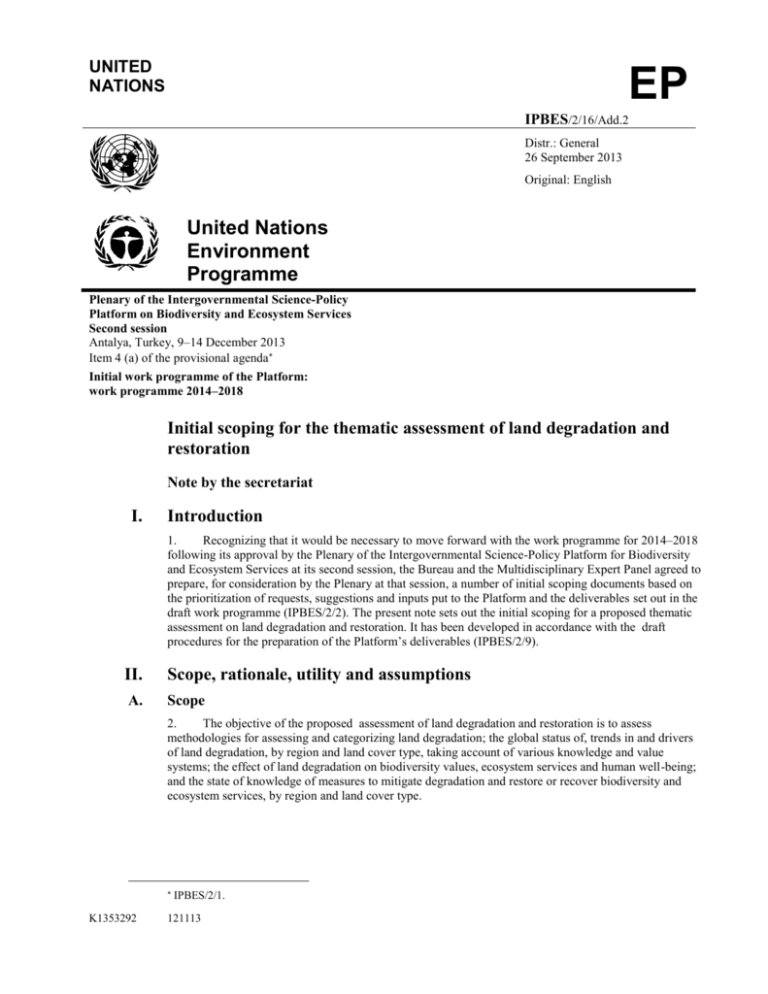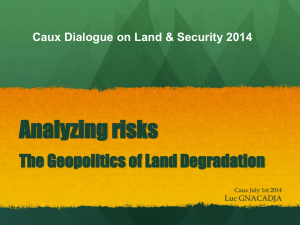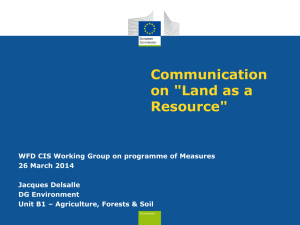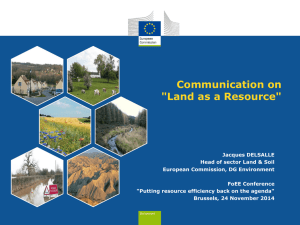IPBES_2_16_Add.2_EN
advertisement

UNITED NATIONS EP IPBES/2/16/Add.2 Distr.: General 26 September 2013 Original: English United Nations Environment Programme Plenary of the Intergovernmental Science-Policy Platform on Biodiversity and Ecosystem Services Second session Antalya, Turkey, 9–14 December 2013 Item 4 (a) of the provisional agenda Initial work programme of the Platform: work programme 2014–2018 Initial scoping for the thematic assessment of land degradation and restoration Note by the secretariat I. Introduction 1. Recognizing that it would be necessary to move forward with the work programme for 2014–2018 following its approval by the Plenary of the Intergovernmental Science-Policy Platform for Biodiversity and Ecosystem Services at its second session, the Bureau and the Multidisciplinary Expert Panel agreed to prepare, for consideration by the Plenary at that session, a number of initial scoping documents based on the prioritization of requests, suggestions and inputs put to the Platform and the deliverables set out in the draft work programme (IPBES/2/2). The present note sets out the initial scoping for a proposed thematic assessment on land degradation and restoration. It has been developed in accordance with the draft procedures for the preparation of the Platform’s deliverables (IPBES/2/9). II. Scope, rationale, utility and assumptions A. Scope 2. The objective of the proposed assessment of land degradation and restoration is to assess methodologies for assessing and categorizing land degradation; the global status of, trends in and drivers of land degradation, by region and land cover type, taking account of various knowledge and value systems; the effect of land degradation on biodiversity values, ecosystem services and human well-being; and the state of knowledge of measures to mitigate degradation and restore or recover biodiversity and ecosystem services, by region and land cover type. K1353292 IPBES/2/1. 121113 IPBES/2/16/Add.2 B. Rationale 3. Land degradation is defined for the purposes of the present note as a long-term decline in biodiversity or ecosystem function or loss of ecosystem services from which land cannot recover unaided. It is a major environmental problem and all continents with permanent human settlement are affected by it in different forms and on various scales. This was acknowledged at the United Nations Conference on Sustainable Development (Rio+20), at which participants stated that they would strive to achieve a landdegradation-neutral world in the context of sustainable development.1 4. Land degradation will remain an important global issue for the twenty-first century because of its adverse impact on agricultural production, biodiversity and quality of life. It is estimated to be responsible for global economic losses of between $50 billion and $400 billion each year. At least 40 per cent of the African continent’s land is degraded. Land degradation is particularly serious and urgent in drylands (where it is called “desertification”, affecting 33 per cent of the earth’s terrestrial surface2). Here, the livelihoods of over one billion people depend on its mitigation, as the land is their main source of food. 5. The multiplicity of forms and causes of degradation makes it a complex issue, a factor that has thus far put a brake on its being taken into consideration, although there have been various efforts to systematize this complexity. 3 Assessments need to be sensitive to context and diverse knowledge systems and must be carried out at comparable and relevant scales 4 to maintain credibility with key stakeholders. They also need to address potential benefits of ecosystem services recovery and future sustainable land management practices. 6. Techniques and strategies to address land degradation exist or are being developed for some, but not all, situations; the proposed assessment will therefore need to identify important knowledge gaps and ways of addressing them. Assessments of the global extent of and trends in land degradation, built up from a compatible series of regional assessments, and of the range of available mitigation and remediation tools as well as the relevant policy context, need to be made consistently for informed decision-making. Policymakers are the main requesters of knowledge on possible synergies and the identification of solutions for short- and medium-term implementation. C. Utility 7. If undertaken, the proposed assessment will: deliver a rigorous scale-sensitive appraisal of the categories of land degradation; assess the global status and drivers of degradation, contextualized using various knowledge systems; assess the significance of degradation for biodiversity and ecosystem services; provide a review of options for remediation, mitigation and recovery of degraded land; identify policy-relevant findings for decision-making and adaptive management by Governments, indigenous and local communities, the private sector and civil society; and create a framework for embedding a systems approach into land degradation monitoring and response systems and the policy decision-making process. By including indigenous and local knowledge, and being sensitive to scale and biome, the assessment will support the development of policy support tools: (a) For achieving Aichi Biodiversity Target 15, which establishes that by 2020 at least 15 per cent of degraded ecosystems must be restored; (b) 1 For contributing to climate change mitigation and adaptation; Outcome document of the United Nations Conference on Sustainable Development, held in Rio de Janeiro, Brazil, from 20 to 22 June 2012, entitled “The future we want”, General Assembly resolution 66/288, annex, para. 206. 2 H. Eswaran, R. Lal, and P. F. Reich, “Land degradation: an overview”, in Responses to Land Degradation, Proceedings, Second International Conference on Land Degradation and Desertification (2005), available at United States Department of Agriculture, http://soils.usda.gov/use/worldsoils/papers/land-degradation-overview.html (accessed 4 October 2013). 3 H. J. Geist. and E. F. Lambin, “Proximate causes and underlying driving forces of tropical deforestation”, BioScience, vol. 52, no. 2, pp.: 143–150; J. F. Reynolds and D. M. Stafford Smith, “Do humans cause deserts?”, in J.F. Reynolds and D.M. Stafford Smith, eds., Global Desertification: Do Humans Cause Deserts? (Dahlem University Press 2002); D. Sietz, M.K.B. Lüdeke and C. Walther, “Categorization of typical vulnerability patterns in global drylands”, Global Environmental Change, vol. 21, No. 2, pp. 431–440. 4 M.S. Reed and others, “Knowledge management for land degradation monitoring and assessment: an analysis of contemporary thinking”, Land Degradation and Development, vol. 24, pp. 307–322 (2013). 2 IPBES/2/16/Add.2 D. (c) For combatting desertification; (d) For addressing the Rio+20 aim of a land-degradation-neutral world. Assumptions 8. The assessment will be based on the current scientific literature, drawing on the work of institutions such as the Convention on Biological Diversity, the Food and Agriculture Organization of the United Nations (FAO), the United Nations Convention to Combat Desertification in those Countries Experiencing Serious Drought and/or Desertification, Particularly in Africa, and the Global Environment Facility. A key focus will be dryland degradation. The Convention on Biological Diversity, with its programme of work on the biological diversity of dry and sub-humid lands, and the Convention on Desertification, are the main multilateral environmental agreements focusing on dry and sub-humid lands. A number of the Aichi Biodiversity Targets of the Convention on Biological Diversity cover drylands and have clear links to matters of concern to the Convention on Desertification (e.g., objective 2 of the 2008– 2018 strategic plan and framework of the Convention on Desertification, “to improve the condition of affected ecosystems”). Two international scientific conferences held under the auspices of the Convention on Desertification have already rallied the scientific community. The eleventh session of the Conference of the Parties to the Convention, held in September 2013, will also shape the scope of the assessment. The assessment of land degradation and restoration will also draw on the FAO Global Soil Partnership and the Global Soil Biodiversity Initiative. Indigenous and local knowledge systems will contribute through the existing literature, as well as through dialogue workshops and community-based work sessions. III. Chapter outline 9. It is contemplated that the results of the thematic assessment will be presented in an eight-chapter report, as set out below. 10. Chapter 1. Introduction to the concepts of land degradation and options for mitigation and remediation of land degradation for various regions and biomes: (a) The concept of land degradation; (b) Categories of land degradation; (c) Land degradation as an ecological phenomenon, including the role of soil biodiversity; (d) Impacts of land degradation on biodiversity and ecosystem services; (e) The context-dependency of concepts of land degradation and its impacts, taking account of various knowledge and value systems; (f) (g) services; (h) The scale-dependency (in time and space) of land degradation and its impacts; Approaches to restoration, mitigation and remediation for biodiversity and ecosystem Policy context of land degradation assessed in the report. 11. Chapter 2. Overview and assessment of methodologies for monitoring land degradation and its impacts in various regions, biomes and scales and in the context of various knowledge and value systems: (a) Methodologies for monitoring land degradation and its impacts; (b) Methodologies for characterizing diverse economic and social impacts (e.g., cultural, psycho-social and shared, spiritual and aesthetic benefits) of land degradation and ecosystem service loss; (c) Methodologies to allow comparison of results carried out in different biomes, and socio-economic contexts and at varying scales. 12. Chapter 3. Global assessment of the status of, trends in and drivers of land degradation, broken down by region and biome type and contextualized for scale and different knowledge and value systems: (a) degradation; Overview of scale (large vs. fine scale) and contextual factors in monitoring land 3 IPBES/2/16/Add.2 (b) Extent, trends and drivers, where possible, of land degradation; (c) Integration of assessment of land degradation with indigenous and local knowledge. 13. Chapter 4. Global assessment of the significance of land degradation for biodiversity and ecosystem services, broken down by region and biome type and contextualized scale and various knowledge and value systems: (a) Overview of scale and contextual factors in assessing impacts as in chapter 3; (b) Extent, trends and drivers of land degradation and ecosystem service loss; (c) Assessment of negative or positive thresholds beyond which recovery is either not possible or can be considered successful; (d) Integration of assessment of land degradation impacts and recovery of biodiversity and ecosystem services with indigenous and local knowledge. 14. Chapter 5. Introduction to the concepts of land restoration, remediation and mitigation for various regions and biomes: (a) The concept of land restoration, remediation and mitigation for various knowledge and value systems; (b) services; (c) (d) services; Approaches to restoration, mitigation and remediation for biodiversity and ecosystem Categories of land restoration, remediation and mitigation; Impacts of land restoration, remediation and mitigation on biodiversity and ecosystem (e) The scale-dependency (in time and space) of land restoration, remediation and mitigation and its impacts. 15. Chapter 6. Global assessment of recovery measures for degraded land, including assessment of the installed capacity for land restoration, in various regions and biomes: (a) Assessment of areal extent, trends and policy context with regard to lands under active management aimed at mitigating or remedying land degradation; (b) Overview of options for recovery of degraded land, including biodiversity restoration and ecosystem services recovery and indigenous and traditional practices regarding biodiversity and ecosystem services management; (c) Overview of options for achieving a land-degradation-neutral world; (d) Scenarios and models to help evaluate the potential for restoration, the role of biodiversity in restoration and the effects of restoration on a range of ecosystem services, such as those related to the water cycle and carbon balance, feedback effects on regional climate and control of aerosols; (e) Identification of policy-relevant findings to support decision-making by Governments, indigenous and local communities, the private sector and civil society. 16. Chapter 7. Appraisal of case studies of positive and negative impacts of land degradation and recovery efforts on economies and on human health and well-being and identification of policy-relevant findings for decision-making by Governments, indigenous and local communities, the private sector and civil society. 17. Chapter 8. Creating a framework for embedding a holistic systems approach in appraisals and policy- and decision-making processes. Deliverables would include a conceptual framework, a typology of tools, methodologies and an assessment of factors that impede and facilitate the embedding of an ecosystems approach in various types of appraisals. 4 IPBES/2/16/Add.2 IV. Process and timetable 18. The proposed process for undertaking the assessment and the timetable for carrying it out are outlined in the following table. Time frame Fourth quarter 2013 Fourth quarter First quarter Second quarter Second quarter Second quarter 2014 Second quarter Third quarter Third/fourth quarters First quarter Second quarter Third quarter 2015 Third/fourth quarters Fourth quarter First quarter 2016 First quarter Actions The Plenary reviews and approves the initial scoping exercise prepared by the Multidisciplinary Expert Panel and requests the Panel and the Bureau, within an agreed cost envelope, to proceed with a full assessment after the detailed scoping study (14 December 2013) The Panel, through the secretariat, requests nominations from Governments and other stakeholders of experts to assist with the scoping process (16 December 2013–31 January 2014) The Panel, via e-mail and teleconferences, selects experts for the scoping study using the approved selection criteria set out in document IPBES/2/9. (1–14 February 2014) The Panel and the Bureau oversee the detailed scoping exercise, including the preparation of an outline, an estimate of costs and an assessment of feasibility (3 months). A scoping meeting is held at the beginning of April 2014 The detailed scoping report is sent to members of the Platform and other stakeholders for review and comment for two weeks in the second half of April 2014 On the basis of the results of the detailed scoping exercise, and comments received from members of the Platform and other stakeholders, the Panel and the Bureau decide whether to proceed with the assessment, assuming that it can be conducted within the budget envelope approved by the Plenary in the first half of May 2014 The Panel, through the secretariat, requests nominations from Governments and other stakeholders for experts to prepare the assessment report. Nominations are to be submitted by the end of June 2014 (1.5 months) The Panel selects the report co-chairs, coordinating lead authors, lead authors and review editors, using the approved selection criteria (1 July–15 August 2014) (1.5 months) The report co-chairs, coordinating lead authors and lead authors prepare the first draft report by mid-February 2015 (6 months). A first author meeting is held in September 2014. Dialogue workshops and community-based work sessions with indigenous and local knowledge-holders are conducted The draft report is reviewed by experts until the end of March 2015 (1.5–2 months) The report co-chairs, coordinating lead authors and lead authors prepare the second draft report and a first draft summary for policymakers under the guidance of the review editors and the Panel (April—June) (3 months). A second author meeting is held in June 2015 The second draft report and the first draft summary for policymakers are reviewed by experts and Governments and other stakeholders during July and August 2015 (2 months) The report co-chairs, coordinating lead authors and lead authors prepare the final draft report and summary for policymakers under the guidance of the review editors and the Panel during September and October 2015 (2 months). A third author meeting is held in October 2015 The summary for policymakers is translated into all official languages of the United Nations by mid-December 2015 at the latest (1.5 months) The final draft report and summary for policymakers are sent to Governments and other stakeholders for final review during January and February 2016 (1.5–2 months). Written comments from Governments on the draft summary for policymakers are strongly encouraged. Such comments are due one week prior to the fourth session of the Plenary The Plenary reviews and accepts the report and reviews and approves the summary for policymakers during its fourth session 5 IPBES/2/16/Add.2 V. Cost estimate 19. The table below shows the estimated cost of conducting the assessment and preparing the assessment report. (United States dollars) Year 2014 Cost item Assumptions Scoping meeting (40 participants: Multidisciplinary Expert Panel/Bureau members, plus experts) Meeting costs (1 week, 40 participants) (25 per cent in kind) 11 250 Travel and DSA (30 x $3,000) 90 000 First author meetings (80 co-chairs, coordinating lead authors and lead authors, plus 4 Panel/Bureau members, plus 1 technical support staff member) Meeting costs (1 week, 85 participants) (25 per cent in kind) 15 000 75 000 Second author meetings (80 co-chairs, coordinating lead authors and lead authors, plus 16 review editors, plus 4 Panel/Bureau members, plus 1 technical support staff member) Meeting costs (1 week, 101 participants) (25 per cent in kind) 18 750 Third author meetings (80 co-chairs, coordinating lead authors and lead authors, plus 16 review editors, plus 4 Panel/Bureau members, plus 1 technical support staff member) Meeting costs (1 week, 101 participants) (25 per cent in kind) Technical support 2016 Total 6 192 000 1 full-time equivalent professional position (50 per cent in kind) Technical support 2015 Travel and DSA (64 x $3,000) Cost Travel and DSA (75 x $3,000) Travel and DSA (75 x $3,000) 1 full-time equivalent professional position (50 per cent in kind) Participation by 2 co-chairs and 2 coordinating lead authors in the fourth session of the Plenary Travel and DSA (3 x $3,000) Dissemination and outreach (summary for policymakers (10 pages) and report (200 pages)) Translation of summary for policymakers into all the official languages of the United Nations, publication and outreach 225 000 18 750 225 000 75 000 9 000 117 000 1 071 750








